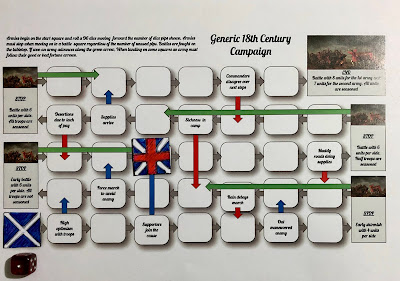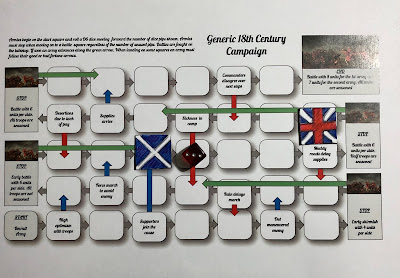A quick reminder the objective of this campaign is to create a series of battles with the purpose of getting advantages for one final battle, and hopefully not more than a handful of battles will be generated. Other than the campaign board and some initial thoughts (see here) there is a bit of making this up as I go along.
Each time a force lands on a battle rectangle a random scenario is selected from the One-Hour Wargames book. The force landing on the rectangle is the attacking side in the scenario. If they win they advance along the green arrow taking them closer the end battle. The other force has nothing to gain, other than denying the advancement of the other force. Although I am thinking of changing this to allow some benefit in the last battle, for example, an additional commander for each victory by a defending force.
The win will benefit the Jacobite forces who will advance 5 squares on the campaign board.
Government forces won began the game with a 4 and land on a square which provides them with supporters in the regions which speeds up their march.
The Jacobite cause gets off to a slow start with a 1.
The low score continues with Government forces scoring a 1.
A score of 3 sees supports flocking to the Jacobite cause.
The march of Government forces is delayed as muddy roads hold up their supplies.
As score of 5 sees Jacobite forces make the first aggressive move and the battle is setup.
A random selection using a D3 for 10's and a D10 for 1's came up with a 1 and an 8 for scenario 18, counter attack, from One-Hour Wargames. There is no battle report for the game other than to say the Highlanders proved unstoppable as they charged forward and captured the bridge before a flanking force of Government troops could create any threat.
Game in action







Good to see the "Snakes and Ladders" board in action Peter.
ReplyDeleteI am hoping it generates 3 to 4 smaller games leading to a final and decisive battle.
DeleteGreat to see how this snakes and ladders board works in action. Very effective yet nice and simple. Looking forward to more of the same.
ReplyDeleteThanks. I expect to make a few tweaks during the campaign as its my first go at working it through.
DeleteSnakes and Campaigns are another brilliant innovation. thanks for sharing the idea. I look forward to seeing how this pans out.
ReplyDeleteThe original idea was to use if for a Warhammer Necromunda campaign with the gangs moving up through the levels of a city hive. We will see if in works for the 18th century. Thanks.
DeleteWhat an interesting and clever way to organise a campaign.
ReplyDeleteIt will be interesting to explore the options using this approach. For example, squares that add event cards for a player when in battle, and the difference in levels may allow the player with the higher level to select more of the terrain.
DeleteSome lovely ideas here, and so readily applicable across different periods.
ReplyDeleteWith a little bit of reworking they could certainly fit other periods. You could even have two boards with events tailored to each particular side. Thanks.
DeleteA clever but simple idea on running a campaign. Has given me lots of ideas and food for thought will be following with interest. Thanks for posting
ReplyDeleteThanks. I hope some of the ideas prove useful.
DeleteJust looking at your board, if the winning army advances fives spaces after the penultimate battle space, they hit a 'snake' :)
ReplyDeleteI was thinking about the Jacobite advance on London and their command deliberations when I added that particular snake.
DeleteBut there's no incentive to win - if you do so you advance 5 and end up worse off than if you lost the battle :)
DeleteThey would advance 2 squares on the green arrow after winning the penultimate battle. The numbers of squares advanced by a winning force differs for each battle.
DeleteI am trying this for sure. Thanks for the idea.
ReplyDeleteGood luck with your campaign.
Deletelove the paper figures!
ReplyDeleteThank you. They are the paper soldier series by Peter Dennis which when copied are increased in size to about 40mm.
DeleteIs there a specific program you used to create that snakes and ladder campaign?
ReplyDeleteI used Google Slides that came free with a Google account.
DeleteInterested in trying this, but still confused how it works. Won't you end up playing some of the battle sizes twice, when the "losing side" catches up? Does one side end up with fewer units or does the trailing side still get, say, six seasoned units even if it has rolled badly and is still on the bottom row?
ReplyDeleteEach time one of the players moves on to a battle square a battle is fought. This can mean the same battle sizes can be fought more than once using the troops defined in the box. I did use the term "early battle" in one box which was a mistake, I should have used a term like small engagement. U hope this helps.
Delete